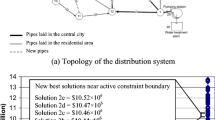Abstract
The pipe sizing of water networks via evolutionary algorithms is of great interest because it allows the selection of alternative economical solutions that meet a set of design requirements. However, available evolutionary methods are numerous, and methodologies to compare the performance of these methods beyond obtaining a minimal solution for a given problem are currently lacking. A methodology to compare algorithms based on an efficiency rate (E) is presented here and applied to the pipe-sizing problem of four medium-sized benchmark networks (Hanoi, New York Tunnel, GoYang and R-9 Joao Pessoa). E numerically determines the performance of a given algorithm while also considering the quality of the obtained solution and the required computational effort. From the wide range of available evolutionary algorithms, four algorithms were selected to implement the methodology: a PseudoGenetic Algorithm (PGA), Particle Swarm Optimization (PSO), a Harmony Search and a modified Shuffled Frog Leaping Algorithm (SFLA). After more than 500,000 simulations, a statistical analysis was performed based on the specific parameters each algorithm requires to operate, and finally, E was analyzed for each network and algorithm. The efficiency measure indicated that PGA is the most efficient algorithm for problems of greater complexity and that HS is the most efficient algorithm for less complex problems. However, the main contribution of this work is that the proposed efficiency ratio provides a neutral strategy to compare optimization algorithms and may be useful in the future to select the most appropriate algorithm for different types of optimization problems.




Similar content being viewed by others
References
Afshar A, Kazemi H, Saadatpour M (2011) Particle swarm optimization for automatic calibration of large scale water quality model (CE-QUAL-W2): application to Karkheh Reservoir, Iran. Water Resour Manag 25:2613–2632. doi:10.1007/s11269-011-9829-7
Afshar A, Shojaei N, Sagharjooghifarahani M (2013) Multiobjective calibration of reservoir water quality modeling using Multiobjective Particle Swarm Optimization (MOPSO). Water Resour Manag 27:1931–1947. doi:10.1007/s11269-013-0263-x
Alperovits E, Shamir U (1977) Design of optimal water distribution systems. Water Resour Res 13:885–900. doi:10.1029/WR013i006p00885
Araujo LS, Ramos H, Coelho ST (2006) Pressure control for leakage minimisation in water distribution systems management. Water Resour Manag 20:133–149. doi:10.1007/s11269-006-4635-3
Artita KS, Kaini P, Nicklow JW (2013) Examining the possibilities: generating alternative watershed-scale BMP designs with evolutionary algorithms. Water Resour Manag 27:3849–3863. doi:10.1007/s11269-013-0375-3
Barlow E, Tanyimboh TT (2014) Multiobjective memetic algorithm applied to the optimisation of water distribution systems. Water Resour Manag 28:2229–2242. doi:10.1007/s11269-014-0608-0
Chung G, Lansey K (2008) Application of the shuffled frog leaping algorithm for the optimization of a general large-scale water supply system. Water Resour Manag 23:797–823. doi:10.1007/s11269-008-9300-6
Elbeltagi E, Hegazy T, Grierson D (2007) A modified shuffled frog-leaping optimization algorithm: applications to project management. Struct Infrastruct Eng 3:53–60. doi:10.1080/15732470500254535
Eusuff MM, Lansey KE (2003) Optimization of water distribution network design using the shuffled frog leaping algorithm. J Water Resour Plan Manag 129:210–225. doi:10.1061/(ASCE)0733-9496(2003)129:3(210)
Fujiwara O, Khang DB (1990) A two-phase decomposition method for optimal design of looped water distribution networks. Water Resour Res 26:539–549. doi:10.1029/WR026i004p00539
Geem ZW (2006) Optimal cost design of water distribution networks using harmony search. Eng Optim 38:259–277. doi:10.1080/03052150500467430
Gomes H, de Bezerra STM, de Carvalho P, Salvino M (2009) Optimal dimensioning model of water distribution systems. Water SA 35:421–431. doi:10.4314/wsa.v35i4
Haddad OB, Tabari MMR, Fallah-Mehdipour E, Mariño MA (2013) Groundwater model calibration by meta-heuristic algorithms. Water Resour Manag 27:2515–2529. doi:10.1007/s11269-013-0300-9
Iglesias-Rey PL, Martínez-Solano FJ, Mora-Meliá D, Martínez-Solano PD (2014) BBLAWN: a combined use of best management practices and an optimization model based on a pseudo-genetic algorithm. Procedia Eng 89:29–36. doi:10.1016/j.proeng.2014.11.156
Jin Y-X, Cheng H-Z, Yan J, Zhang L (2007) New discrete method for particle swarm optimization and its application in transmission network expansion planning. Electr Power Syst Res 77:227–233. doi:10.1016/j.epsr.2006.02.016
Kennedy J, Eberhart R (1995) Particle swarm optimization. Proceedings of ICNN’95 - International Conference on Neural Networks. IEEE, pp 1942–1948. doi:10.1109/ICNN.1995.488968
Kim JH, Kim TG, Kim JH, Yoon YN (1994) A study on the pipe network system design using non-linear programming. J Korean Water Resour Assoc 27:59–67
Kollat JB, Reed PM (2006) Comparing state-of-the-art evolutionary multi-objective algorithms for long-term groundwater monitoring design. Adv Water Resour 29:792–807. doi:10.1016/j.advwatres.2005.07.010
Louati MH, Benabdallah S, Lebdi F, Milutin D (2011) Application of a genetic algorithm for the optimization of a complex reservoir system in tunisia. Water Resour Manag 25:2387–2404. doi:10.1007/s11269-011-9814-1
Marchi A, Dandy G, Wilkins A, Rohrlach H (2014) Methodology for Comparing Evolutionary Algorithms for Optimization of Water Distribution Systems. doi: 10.1061/(ASCE)WR.1943-5452.0000321
Mora-Melia D, Iglesias-Rey P, Fuertes-Miquel V, Martinez-Solano F (2010) Application of the harmony search algorithm to water distribution networks design. Taylor & Francis Group. pp 265–271. doi: 10.1201/b10999-67
Mora-Melia D, Iglesias-Rey PL, Martinez-Solano FJ, Fuertes-Miquel VS (2013) Design of water distribution networks using a pseudo-genetic algorithm and sensitivity of genetic operators. Water Resour Manag 27:4149–4162. doi:10.1007/s11269-013-0400-6
Ostadrahimi L, Mariño MA, Afshar A (2011) Multi-reservoir operation rules: multi-swarm PSO-based optimization approach. Water Resour Manag 26:407–427. doi:10.1007/s11269-011-9924-9
Rossman LA (2000) EPANET 2.0 User’s manual. EPA/600/R-00/057, Water Supply and Water Resources Div., National Risk Management Research Laboratory, Cincinnatti (USA)
Savic DA, Walters GA (1997) Genetic algorithms for least-cost design of water distribution networks. J Water Resour Plan Manag 123:67–77. doi:10.1061/(ASCE)0733-9496(1997)123:2(67)
Schaake J, Lai FH (1969) Linear programming and dynamic programming application to water distribution network design. M.I.T. Hydrodynamics Laboratory, Cambridge
Wang Q, Guidolin M, Savic D, Kapelan Z (2014) Two-Objective Design of Benchmark Problems of a Water Distribution System via MOEAs: Towards the Best-Known Approximation of the True Pareto Front. J Water Resour Plan Manag 04014060. doi: 10.1061/(ASCE)WR.1943-5452.0000460
Acknowledgments
This research study was funded by the Chilean CONICYT grant under the Program FONDECYT Initiation for research in 2013 and 2014 (Project folio 11130666 and 11140128, respectively).
Author information
Authors and Affiliations
Corresponding author
Rights and permissions
About this article
Cite this article
Mora-Melia, D., Iglesias-Rey, P.L., Martinez-Solano, F.J. et al. Efficiency of Evolutionary Algorithms in Water Network Pipe Sizing. Water Resour Manage 29, 4817–4831 (2015). https://doi.org/10.1007/s11269-015-1092-x
Received:
Accepted:
Published:
Issue Date:
DOI: https://doi.org/10.1007/s11269-015-1092-x




